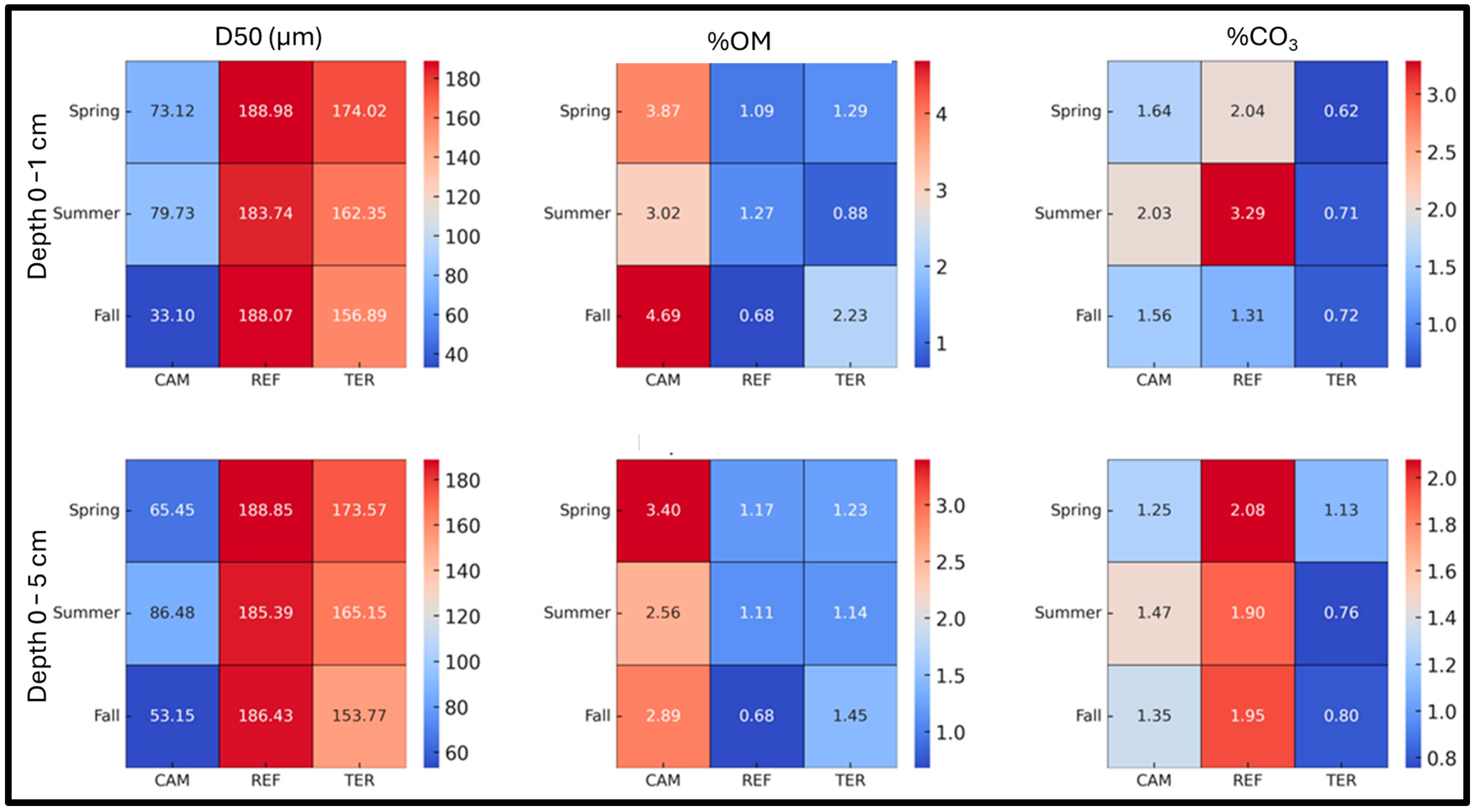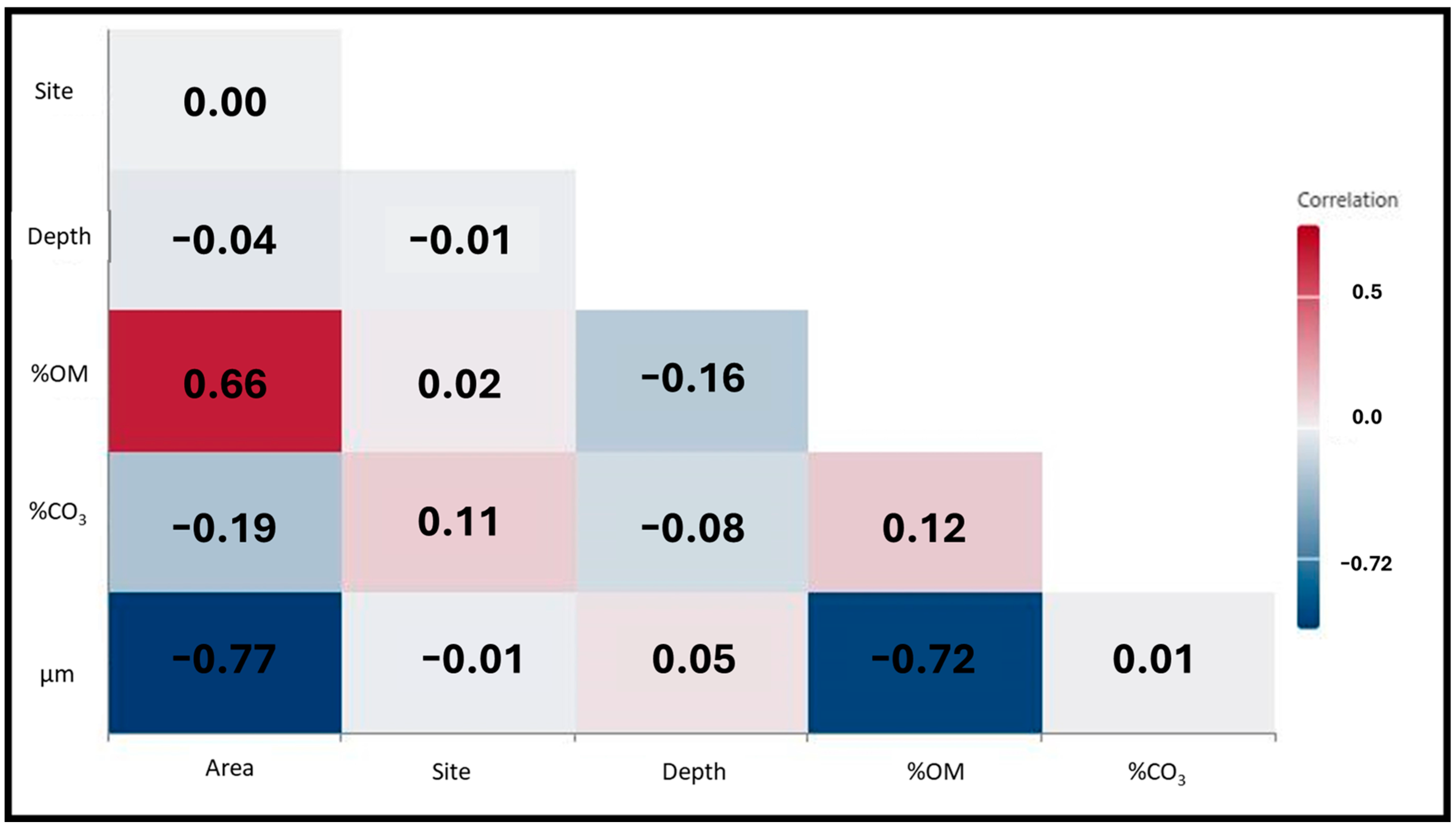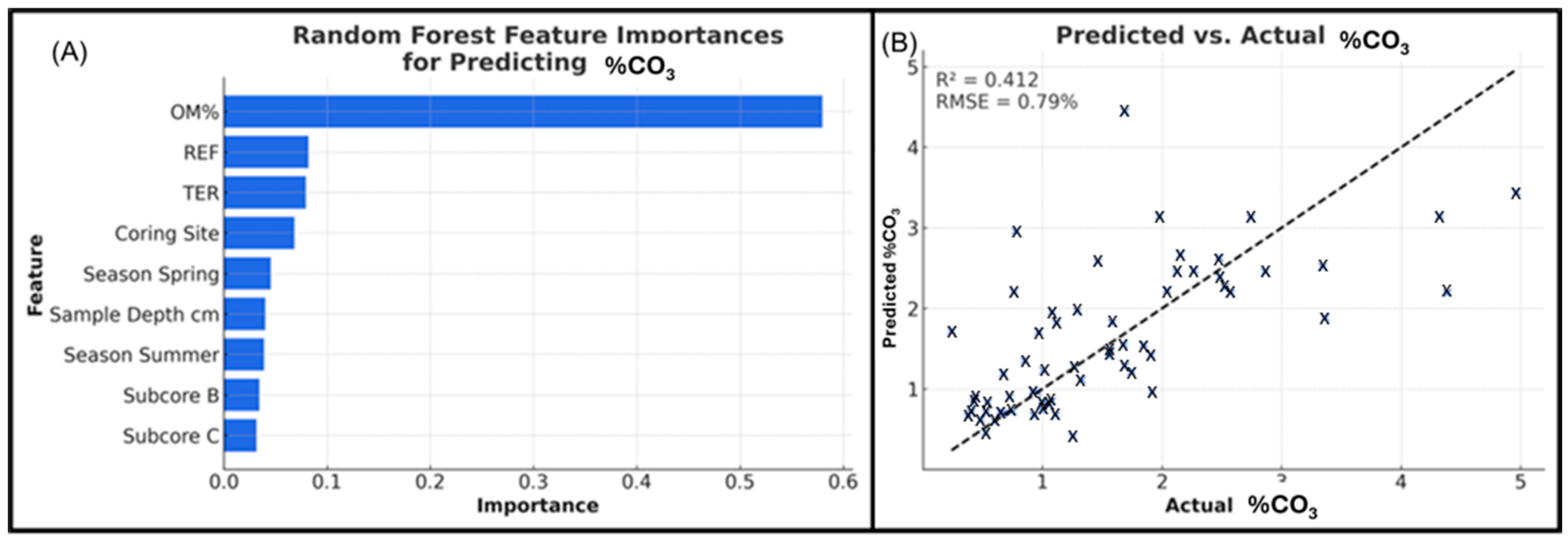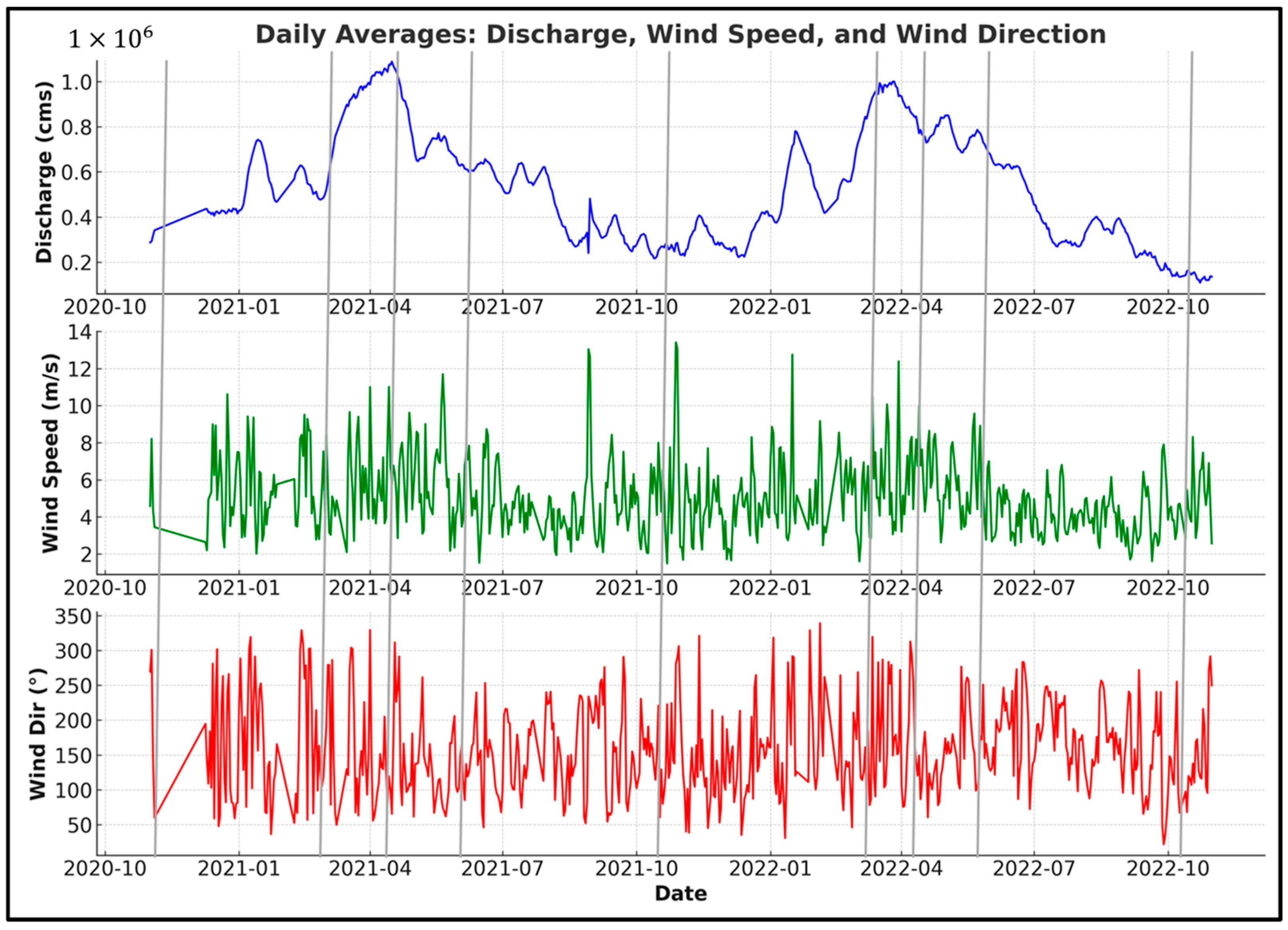Time Series Changes of Surficial Sediments on Eastern Ship Shoal, Louisiana Shelf
Abstract
1. Introduction
1.1. Study Site
1.2. Hypotheses
2. Materials and Methods
2.1. Sample Collection and Preparation
2.2. Sediment Analysis
2.3. Temporal–Spatial Analysis
2.4. Depth Variation
2.5. Correlation Analysis
2.6. Random Forest Regression
3. Results
3.1. Grain Size Distribution
3.2. Seasonal Trends
3.2.1. Seasonal Median Grain Size Distribution
3.2.2. Percent Organic Matter
3.2.3. Percent Carbonate
3.3. Comparative Analysis
3.4. Regression Modeling
4. Discussion
4.1. Sources and Transport of Sediments
4.2. Sources and Transport of Organic Matter and Carbonate Content
4.3. Integrated Analysis and Predictive Modeling
5. Conclusions
Author Contributions
Funding
Data Availability Statement
Acknowledgments
Conflicts of Interest
References
- Penland, S.; Suter, J.R. Transgressive depositional systems of the Mississippi delta plain: A model for barrier shoreline and shelf sand development. J. Sediment. Petrol. 1988, 58, 932–949. [Google Scholar]
- Williams, S.J.; Flocks, J.; Jenkins, C.J.; Kulp, M.; Penland, S.; Reid, J.A. Surficial Sediment Character of the Louisiana Offshore Continental Shelf Region: A GIS Compilation; USGS Open-File Report 2006-1195; U.S. Geological Survey: Reston, VA, USA, 2006.
- Gartelman, A.; Xu, K.; Maiti, K.; Liu, H.; Moran, K.; Wilson, C.; Roberts, B.J.; Nelson, J. Sedimentation processes and morphological changes in a dredge pit and surrounding environment on Ship Shoal in the northern Gulf of Mexico. Mar. Geol. 2024, 470, 107218. [Google Scholar] [CrossRef]
- Zhang, W.; Xu, K.; Herke, C.; Alawneh, O.; Jafari, N.; Maiti, K. Spatial and temporal variations of seabed sediment characteristics in the inner Louisiana shelf. Mar. Geol. 2023, 463, 107115. [Google Scholar] [CrossRef]
- Gordon, E.S.; Goñi, M.A. Sources and distribution of terrigenous organic matter delivered by the Atchafalaya River to sediments in the northern Gulf of Mexico. Geochim. Cosmochim. Acta 2003, 67, 2359–2375. [Google Scholar] [CrossRef]
- Liu, H.; Xu, K.; Bentley, S.J. Sediment transport and infilling processes in dredge pits along the Louisiana continental shelf. Sediment. Geol. 2022, 425, 106021. [Google Scholar]
- Maiti, K.; Xu, K.; Bianchi, T.S. Organic carbon cycling in Gulf of Mexico sediments: Impacts of fluvial sediments and hydrodynamics. Estuar. Coast. Shelf Sci. 2020, 233, 106550. [Google Scholar] [CrossRef]
- Suter, J.R.; Penland, S. Evolution and depositional patterns of transgressive sand bodies along the Mississippi River delta plain: Insights for barrier island restoration and sediment dynamics. J. Coast. Res. 1987, 3, 487–502. [Google Scholar]
- Zhang, W.; Xu, K.; Harris, C.K.; Bentley, S.J.; White, L.D. Sedimentation patterns and storm-induced sediment dispersal in a dredged sand borrow area, Louisiana inner shelf. Mar. Geol. 2023, 462, 107114. [Google Scholar] [CrossRef]
- Heiri, O.; Lotter, A.F.; Lemcke, G. Loss on ignition as a method for estimating organic and carbonate content in sediments: Reproducibility and comparability of results. J. Paleolimnol. 2001, 25, 101–110. [Google Scholar] [CrossRef]
- Pedregosa, F.; Varoquaux, G.; Gramfort, A.; Michel, V.; Thirion, B.; Grisel, O.; Blondel, M.; Prettenhofer, P.; Weiss, R.; Dubourg, V. Scikit-learn: Machine learning in Python. J. Mach. Learn. Res. 2011, 12, 2825–2830. [Google Scholar]
- Bomer, E.J.; Bentley, S.J.; Hughes, J.E.T.; Wilson, C.A.; Crawford, F.; Xu, K.H. Deltaic morphodynamics and stratigraphic evolution of middle Barataria Bay and middle Breton sound regions, Louisiana, USA: Implications for River-Sediment Diversions. Estuar. Coast. Shelf Sci. 2019, 224, 20–33. [Google Scholar] [CrossRef]
- Wang, J.; Xu, K.H.; Bentley, S.J.; White, C.; Zhang, X.; Liu, H. Degradation of the Plaquemines sub-delta and relative sea-level in eastern Mississippi deltaic coast during late Holocene. Estuar. Coast. Shelf Sci. 2019, 227, 106344. [Google Scholar] [CrossRef]
- Smith, E.; Livingston, R.J.; Lewis, F.G. Sediment characteristics and benthic infauna in Apalachicola Bay, Florida. Estuaries 2000, 23, 416–427. [Google Scholar] [CrossRef]
- Keogh, M.E.; Törnqvist, T.E.; Kolker, A.S.; Erkens, G.; Bridgeman, J.G. Organic matter accretion, shallow subsidence, and river delta sustainability. J. Geophys. Res. Earth Surf. 2021, 126, e2021JF006231. [Google Scholar] [CrossRef]
- Drexler, J.Z.; Ewel, K.C. Effect of the 1997–1998 ENSO-related drought on hydrology and salinity in a Pacific Coast estuary. Estuaries 2001, 24, 337–347. [Google Scholar] [CrossRef]
- Sommerfield, C.K.; Nittrouer, C.A.; Alexander, C.R. 1997 flood deposit in the lower Columbia River: High-resolution mapping and sedimentological characterization. Estuar. Coast. Shelf Sci. 1999, 50, 703–725. [Google Scholar]
- Barnard, P.L.; Schoellhamer, D.H.; Jaffe, B.E.; McKee, L.J. Sediment transport in the San Francisco Bay coastal system: An overview. Mar. Geol. 2013, 345, 3–17. [Google Scholar] [CrossRef]
- Neubauer, S.C. Contributions of mineral and organic components to tidal freshwater marsh accretion. Estuar. Coast. Shelf Sci. 2008, 78, 78–88. [Google Scholar] [CrossRef]
- Hatcher, P.G.; McGillivary, P.A. Humic substances in estuarine sediments of the US Gulf Coast. Geochim. Cosmochim. Acta 1979, 43, 1341–1348. [Google Scholar]
- Jay, K.R.; Hacker, S.D.; Hagen, C.J.; Stepanek, J.; Moore, L.J.; Ruggiero, P. Quantifying the relative importance of sand deposition and dune grasses to carbon storage in US Central Atlantic Coast dunes. Estuaries Coasts 2025, 48, 60. [Google Scholar] [CrossRef]
- Gelfenbaum, G.; Stumpf, R.P.; Pennock, J.R. Hydrodynamics and sediment transport in Grays Harbor, Washington. Estuaries 1991, 14, 224–238. [Google Scholar]
- Corbett, D.R.; McKee, B.; Duncan, D. An evaluation of mobile mud dynamics in the Mississippi River deltaic region. Mar. Geol. 2004, 209, 91–112. [Google Scholar] [CrossRef]
- Alexander, C.R.; Pilkey, O.H.; Neal, W.J.; Estes, E.; Kelley, J.T.; Parmenter, C.; Hiland, M.W.; Steel, N.C.; Cacchione, D.A.; Schwab, W.C. Sedimentology of Puget Sound. Mar. Geol. 1986, 70, 1–28. [Google Scholar]
- Christiansen, T.; Wiberg, P.L.; Milligan, T.G. Flow and sediment transport on a tidal salt marsh surface. Estuar. Coast. Shelf Sci. 2000, 50, 315–331. [Google Scholar] [CrossRef]
- Locker, S.D.; Hine, A.C.; Brooks, G.R.; Twichell, D.C.; Donoghue, J.F.; Davis, R.A.; Gelfenbaum, G.; Mayer, L.A.; FitzGerald, D.M.; Cunningham, R.H. Regional stratigraphic framework linking continental shelf and coastal sedimentary deposits of the Gulf of Mexico. Gulf Coast Assoc. Geol. Soc. Trans. 1999, 49, 675–681. Available online: https://archives.datapages.com/data/gcags/data/049/049001/pdfs/0675.pdf (accessed on 8 August 2025).
- Hale, S.S.; Buffum, H.W.; Kiddon, J.A.; Hughes, M.M. Subtidal benthic invertebrates shifting northward along the US Atlantic Coast. Estuaries Coasts 2017, 40, 174–185. [Google Scholar] [CrossRef] [PubMed]
- Jenkins, C.J.; Reid, J.M.; Reid, J.A.; Hastings, M.E.; Williams, S.J.; Poppe, L.J. usSEABED: Atlantic Coast Offshore Surficial Sediment Data Release; U.S. Geological Survey Data Series; U.S. Geological Survey: Reston, VA, USA, 2005; Volume 118, pp. 1–55. Available online: https://www.academia.edu/download/78326339/fa3fe638a80bb7bc0d6b6bef6693aaa347ca.pdf (accessed on 8 August 2025).
- Allison, M.A.; Kineke, G.C.; Gordon, E.S.; Goni, M.A. Development and reworking of a seasonal flood deposit on the inner continental shelf off the Atchafalaya River. Cont. Shelf Res. 2000, 20, 2267–2294. [Google Scholar] [CrossRef]
- Pilkey, O.H.; Morton, R.W.; Luternauer, J. The carbonate fraction of beach and dune sands. Sedimentology 1967, 9, 311–327. [Google Scholar] [CrossRef]
- Law, B.A.; Milligan, T.G.; Hill, P.S.; Newgard, J.; Wheatcroft, R.A.; Wiberg, P.L. Flocculation on a muddy intertidal flat in Willapa Bay, Washington, Part I: A regional survey of the grain size of surficial sediments. Cont. Shelf Res. 2013, 60 (Supplement), S136–S144. [Google Scholar] [CrossRef]
- Barnard, P.L.; Erikson, L.H.; Hansen, J.E. Monitoring and modeling nearshore dredge disposal for indirect beach nourishment, Ocean Beach, San Francisco, CA. Coast. Eng. 2009, 56, 86–95. [Google Scholar]
- Hickey, B.M.; Kudela, R.M.; Nash, J.D.; Bruland, K.W.; Jay, D.A.; MacCready, P.; Banas, N.S.; Peterson, T.D.; McCabe, R.M.; Dever, E.P.; et al. River influences on shelf ecosystems: Introduction and synthesis. J. Geophys. Res. Ocean. 2010, 115, C00B17. [Google Scholar] [CrossRef]
- Wehmiller, J.F.; Groot, J.J.; Benson, R.N. Palynological, foraminiferal and aminostratigraphic studies of Quaternary sediments from the US middle Atlantic upper continental slope, continental shelf and coastal plain. Quat. Sci. Rev. 1995, 14, 583–605. [Google Scholar] [CrossRef]
- Balsam, W.L.; Beeson, J.P. Sea-Floor Sediment Distribution in the Gulf of Mexico. Deep Sea Res. Part I Oceanogr. Res. Pap. 2003, 50, 1421–1444. [Google Scholar] [CrossRef]
- Baker, E.T.; Milburn, H.B.; Tennant, D.A. Field assessment of sediment trap efficiency under varying flow conditions. J. Mar. Res. 1988, 46, 573–592. [Google Scholar] [CrossRef]
- Malaizé, B.; Bertran, P.; Carbonel, P.; Bonnissent, D.; Charlier, K.; Galop, D.; Imbert, D.; Serrand, N.; Stouvenot, C.; Pujol, C. Hurricanes and climate in the Caribbean during the past 3700 years BP. Holocene 2011, 21, 911–924. [Google Scholar] [CrossRef]
- Berelson, W.M.; McManus, J.; Coale, K.H.; Johnson, K.S.; Kilgore, T.; Burdige, D.; Pilskaln, C. Biogenic matter diagenesis on the sea floor: A comparison between the Gulf of Mexico and the California margin. Mar. Chem. 1996, 81, 71–99. [Google Scholar] [CrossRef]
- Berelson, W.M.; McManus, J.; Coale, K.H.; Johnson, K.S.; Kilgore, T.E.; Burdige, D.J.; Hammond, D.E.; Santschi, P.H.; Passow, U.; Chanton, J.P. Early diagenesis in the Gulf of Mexico. Deep Sea Res. Part I 2003, 44, 1–26. [Google Scholar]
- Wang, Z.A.; Wanninkhof, R.; Cai, W.-J.; Byrne, R.H.; Hu, X.; Peng, T.-H.; Huang, W.-J. The marine inorganic carbon system along the Gulf of Mexico and Atlantic coasts of the United States. Limnol. Oceanogr. 2013, 58, 325–342. [Google Scholar] [CrossRef]













| Area | Site | Depth (cm) | Subcores | Season | Hydrodynamic |
|---|---|---|---|---|---|
| REF | 1 | 0–1 | A | Spring (March, April, May) | Wind Direction |
| TER | 2 | 0–5 | B | Summer (June, July, August) | Wind Speed |
| CAM | 3 | C | Fall (September, October, November) | Wave Height |
| Area | Depth (cm) | Mean (µm) | Median (µm) | SD (µm) | Min (µm) | Max (µm) | Count |
|---|---|---|---|---|---|---|---|
| REF | 0–1 | 186.70 | 183.40 | 10.69 | 173.65 | 217.15 | 45 |
| REF | 0–5 | 187.29 | 183.46 | 10.21 | 172.96 | 224.12 | 54 |
| TER | 0–1 | 166.61 | 172.27 | 34.92 | 6.68 | 209.35 | 51 |
| TER | 0–5 | 165.57 | 168.42 | 35.20 | 19.81 | 215.36 | 54 |
| CAM | 0–1 | 61.65 | 17.71 | 67.08 | 6.10 | 203.00 | 53 |
| CAM | 0–5 | 68.65 | 32.60 | 66.79 | 5.54 | 203.37 | 53 |
| Area | Depth (cm) | Mean (%) | Median (%) | SD (%) | Min (%) | Max (%) | Count |
|---|---|---|---|---|---|---|---|
| REF | 0–1 | 1.08 | 1.03 | 0.44 | 0.24 | 2.13 | 45 |
| REF | 0–5 | 1.07 | 1.08 | 0.37 | 0.6 | 3.21 | 54 |
| TER | 0–1 | 1.57 | 1.29 | 0.85 | 0.63 | 5.76 | 51 |
| TER | 0–5 | 1.29 | 1.19 | 0.44 | 0.62 | 3.29 | 54 |
| CAM | 0–1 | 3.86 | 3.41 | 2.12 | 1.21 | 8.11 | 54 |
| CAM | 0–5 | 2.95 | 2.32 | 1.88 | 0.75 | 8.41 | 54 |
| Area | Depth (cm) | Mean (%) | Median (%) | SD | Min (%) | Max (%) | Count |
|---|---|---|---|---|---|---|---|
| REF | 1 | 2.39 | 1.36 | 2.29 | 0.24 | 10.45 | 45 |
| REF | 5 | 2 | 1.57 | 1.36 | 0.71 | 7.45 | 54 |
| TER | 1 | 0.67 | 0.56 | 0.42 | 0.23 | 2.73 | 51 |
| TER | 5 | 0.96 | 0.69 | 1.26 | 0.37 | 9.63 | 54 |
| CAM | 1 | 1.74 | 1.54 | 1.28 | 0.47 | 8.84 | 54 |
| CAM | 5 | 1.36 | 1.05 | 0.76 | 0.54 | 3.78 | 54 |
| Year_Season | Area | Clay | Silt | Sand |
|---|---|---|---|---|
| 2020_Fall | TER | 0.81 | 1.14 | 98.06 |
| 2021_Spring | TER | 0.38 | 0.44 | 99.18 |
| 2021_Summer | TER | 0.95 | 1.17 | 97.88 |
| 2021_Fall | TER | 8.12 | 15.50 | 76.38 |
| 2022_Spring | TER | 1.56 | 2.42 | 96.02 |
| 2022_Summer | TER | 3.31 | 6.27 | 90.42 |
| 2021_Spring | CAM | 11.09 | 35.19 | 53.73 |
| 2021_Summer | CAM | 7.43 | 17.53 | 75.03 |
| 2021_Fall | CAM | 25.31 | 55.65 | 19.03 |
| 2022_Spring | CAM | 20.99 | 50.27 | 28.74 |
| 2022_Summer | CAM | 18.63 | 57.20 | 24.17 |
| 2022_Fall | CAM | 22.61 | 41.62 | 35.77 |
| 2021_Spring | REF | 0.64 | 0.74 | 98.62 |
| 2021_Summer | REF | 0.64 | 0.68 | 98.68 |
| 2021_Fall | REF | 1.24 | 1.64 | 97.12 |
| 2022_Spring | REF | 0.85 | 0.67 | 98.49 |
| 2022_Summer | REF | 0.77 | 0.61 | 98.62 |
| 2022_Fall | REF | 1.50 | 1.77 | 96.72 |
| Location | Environment | References | %OM | %CO3 | Median Grain Size (µm) |
|---|---|---|---|---|---|
| Apalachicola Bay | coastal | Smith, E. (2000) [14] | 6 | 50 | |
| Gulf Coast Marshes | coastal | Keogh, M. (2021) [15] | 26 | ||
| California Estuary | coastal | Drexler, J. (2001) [16] | 10 | 50 | |
| Columbia River Estuary | coastal | Sommerfield, C. (1999) [17] | 1.5 | 250 | |
| San Francisco Bay | coastal | Ralston, D. (2013) [18] | 6.5 | 80 | |
| Tidal Freshwater Marshes (Atlantic) | coastal | Neubauer, S. (2008) [19] | 15 | 30 | |
| Gulf Coast Estuaries | coastal | Hatcher, P. (1979) [20] | 12 | 30 | |
| Central Atlantic Dunes | coastal | Jay, K. (2025) [21] | 0.9 | 600 | |
| Grays Harbor, WA | coastal | Gelfenbaum, G. (1991) [22] | 280 | ||
| Mississippi River Delta | coastal | Corbett, D. (2004) [23] | 3.2 | 20 | 100 |
| Puget Sound | coastal | Alexander, C. (1986) [24] | 4.2 | 10 | 60 |
| Virginia Coast Reserve | coastal | Christiansen, T. (2000) [25] | 8 | 50 | |
| Ship Shoal, LA | inner shelf | This Study | 1.7 | <10.0 | 126 |
| Gulf Shelf | inner shelf | Locker, S. (1999) [26] | 60 | 150 | |
| Atlantic Coast Subtidal Zones | inner shelf | Hale, S. (2017) [27] | 2.3 | 250 | |
| Atlantic Coast Offshore | inner shelf | Jenkins, C. (2005) [28] | 1.2 | 35 | 180 |
| Atchafalaya Shelf | inner shelf | Allison, M. (2000) [29] | 2.8 | 70 | |
| Atlantic Coast Beaches | inner shelf | Pilkey, O. (1967) [30] | 0.8 | 50 | 450 |
| Oregon Coast Shelf | inner shelf | Law, B.A. (2013) [31] | 15 | ||
| San Francisco, CA (West Coast) | inner shelf | Barnard, P. (2009) [32] | 350 | ||
| Southern California Bight | inner shelf | Hickey, B. (2010) [33] | 1 | 20 | 120 |
| Mid-Atlantic Shelf | shelf margin | Wehmiller, J. (1995) [34] | 40 | 200 | |
| Northern Gulf | shelf margin | Balsam, W. (2005) [35] | 2.5 | 35 | 90 |
| Pacific Coast and Gulf of Mexico | shelf margin | Baker, E. (1988) [36] | 2.5 | 15 | 200 |
| Atlantic Margin | shelf margin | Malaizé, B (2011) [37] | 3.5 | 22 | 70 |
| California Margin | shelf margin | Berelson, W. (1997) [38] | 2 | 25 | 140 |
| Gulf Margin | shelf margin | Berelson, W. (2003) [39] | 1.5 | 25 | 140 |
| Atlantic Coast Shelf | shelf margin | Wang, Z. (2013) [40] | 30 | 150 |
Disclaimer/Publisher’s Note: The statements, opinions and data contained in all publications are solely those of the individual author(s) and contributor(s) and not of MDPI and/or the editor(s). MDPI and/or the editor(s) disclaim responsibility for any injury to people or property resulting from any ideas, methods, instructions or products referred to in the content. |
© 2025 by the authors. Licensee MDPI, Basel, Switzerland. This article is an open access article distributed under the terms and conditions of the Creative Commons Attribution (CC BY) license (https://creativecommons.org/licenses/by/4.0/).
Share and Cite
Gartelman, A.; Xu, K.; Roberts, B.J.; Johnson, D.S.; Liotta, M. Time Series Changes of Surficial Sediments on Eastern Ship Shoal, Louisiana Shelf. J. Mar. Sci. Eng. 2025, 13, 1753. https://doi.org/10.3390/jmse13091753
Gartelman A, Xu K, Roberts BJ, Johnson DS, Liotta M. Time Series Changes of Surficial Sediments on Eastern Ship Shoal, Louisiana Shelf. Journal of Marine Science and Engineering. 2025; 13(9):1753. https://doi.org/10.3390/jmse13091753
Chicago/Turabian StyleGartelman, Adam, Kehui Xu, Brian J. Roberts, David Samuel Johnson, and Madison Liotta. 2025. "Time Series Changes of Surficial Sediments on Eastern Ship Shoal, Louisiana Shelf" Journal of Marine Science and Engineering 13, no. 9: 1753. https://doi.org/10.3390/jmse13091753
APA StyleGartelman, A., Xu, K., Roberts, B. J., Johnson, D. S., & Liotta, M. (2025). Time Series Changes of Surficial Sediments on Eastern Ship Shoal, Louisiana Shelf. Journal of Marine Science and Engineering, 13(9), 1753. https://doi.org/10.3390/jmse13091753








